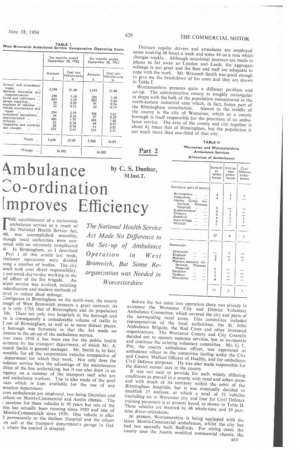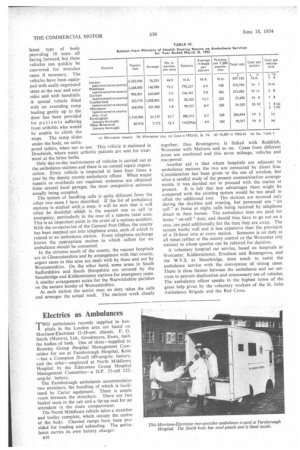Nmbulance by C. S. Dunbar,
Page 49

Page 50

If you've noticed an error in this article please click here to report it so we can fix it.
Minst.T.
o-o rdinati on Emproves Efficiency
FHE establishment of a nationwide ambulance service as a result of the National Health Service Act, 146. was accomplished smoothly, though local authorities were conanted with an extremely complicated sk. In Birmingham, as I described
Part 1 of this article last week, ibulance operations were divided long a number of bodies. The city mull took over direct responsibility, I entrusted day-to-day working to the ief officer of the fire brigade. An icient service was evolved, entailing ndardization and modern methods of ntrol to reduce dead mileage.
Contiguous to Birmingham on the north-west, the county rough of West Bromwich presents a great contrast; its ;a is only 1/7th that of Birmingham and its population 3th. •There are only two hospitals in the borough and re is consequently a considerable volume of traffic in 1 out of Birmingham, as well as to more distant places.
e borough was fortunate in that the Act made no 'erence to the set-up of the ambulance service.
-.:ver since 1930 it has been run for the public health lartment by the transport department, of which Mr. A. tcomb Smith is general manager. Mr. Smith is, in fact, aonsible for all the corporation vehicles irrespective of department for which they work. Not only does the ulance service have the advantage of the maintenance lities of the bus undertaking, but it can also draw in an :rgency on a number of the transport staff who are ned ambulance workers. Use is also made of the pool cars which is kept available for the use of any 'oration department,
:.ven ambulances arc employed, two being Daimlers and others on Morris-Commercial and Austin chassis. The i sanction for these vehicles is 10 years but one of the tins has actually been running since 1929 and one of Morris-Commercials since 1939. One vehicle is allo I permanently to the Hallam Hospital and the others on call at the transport department's garage in Oak where the control is situated. Before the Act came into operation there was already in existence the Worcester City and District Voluntary Ambulance Committee, which covered the city and parts of the surrounding rural areas. This committee included representatives of the local authorities, the St. John Ambulance Brigade, the Red Cross and other interested organizations. The Worcester County and City Councils decided not to operate separate services, but to co-operate and continue the existing voluntary committee. Mr. G. L. Pitt, the county ambulance officer, was appointed as ambulance officer to the committee (acting under the City and County Medical Officers of Health), and for ambulance Civil Defence purposes. He was also made responsible for the district nurses' cars in the county.
It was not easy to provide for such widely differing conditions as prevail in a county with rural and urban areas and with much of its territory within the orbit of the Birmingham hospitals, but it was eventually decided to establish 15 stations, at which a total of 52 vehicles (including six in Worcester city and four for Civil Defence training purposes) is at present based, as shown in Table These vehicles are manned by 48 whole-time and 10 parttime driver-attendants.
At present, Worcestershire is being equipPed with the latest Morris-Commercial ambulances, whilst the city has had two specially built Bedfords. For sitting cases, the county uses the Austin modified commercial chassis, the
District Papulelion
London 3,355,946
(administrative county)
Middlesex (administrative county) 2,268,000 Durham (administrative county) 901,821 Cumberland
(administrative county)
223,710
Worcester 458,900
(administrative county plus city)
Birmingham (county borough) 1,110,900 West Bromwich (county borough) 87,910
latest type of body providing 10 seats all facing forward, but these vehicles can quickly be converted for stretcher cases if necessary. The vehicles have been equipped with easily negotiated steps at the rear and near sides and with handrails. A special vehicle fitted with an extending ramp leading gently up to the door has been provided for patients suffering from arthritis who would be unable to climb the steps. The ramp slides under the body, on rattleproof rollers, when not in use. This vehicle is stationed in Droitwich, where many arthritic patients are sent for treatment at the brine baths.
Only day-to-day maintenance of vehicles is milled out at the ambulance stations and there is no central repair organization. Every vehicle is inspected at least four times a year by the deputy county ambulance officer. When major repairs or overhauls are required, estimates are obtained from several local garages, the most competitive estimate usually being accepted.
The system of handling calls is quite different from the other two cases I have described. If the list of ambulance stations is studied with a map, it will be seen that it will often be doubtful which is the nearest one to call in emergency, particularly in the case of a remote rural area. This is an important point in the event of a serious accident. With the co-operation of the General Post Office, the county has been mapped out into telephone areas, each of which is related to an ambulance station. Every telephone exchange knows the appropriate station to which callers for an ambulance should be connected.
In the extreme south of the county, the nearest hospitals are in Gloucestershire and by arrangement with that county, urgent cases in this area are dealt with by them and not by Worcestershire. On the other hand, some areas in South Staffordshire and South Shropshire are covered by the Stotninidge and Kiddenninster stations for emergency cases. A similar arrangement exists for the Warwickshire parishes on the eastern border of Worcestershire.
At each station the senior man on duty takes the calls and arranges the actual work. The stations work closely together; thus Bromsgrove is linked with Redditch, Worcester with Malvern and so on. Cases from different areas are combined and this saves mileage, vehicles and manpower.
Another aid is that where hospitals are adjacent to ambulance stations the two are connected by direct line. Consideration has been given to the use of wireless, but after a careful study of the present communication arrangements, it was decided not to proceed with the matter at present. It is felt that any advantages there might be compared with the existing system would be too small to offset the additional cost. The stations are manned only during the daytime and evening, but personnel are "on call •' at home at night, calls being received by telephone direct to their homes. The ambulance men are paid for home 'on-call" duty, and should they have to go out on a case, are paid additionally for the time they are away. The system works well and is less expensive than the provision of a 24-hour rota at every station. Someone is on duty at all times (either at the county control or the Worcester city station) to whom queries can be referred for decision.
A voluntary hospital car service, based on hospitals at Worcester, Kidderminster, Evesham and Bromsgrove, and the W.V.S. at Stourbridge, does much to assist the ambulance service with the conveyance of sitting cases. There is close liaison between the ambulance and car services to prevent duplication and unnecessary use of vehicles. The ambulance officer speaks in the highest terms of the great help given by the voluntary workers of the St. John Ambulance Brigade and the Red Cross.




























































































